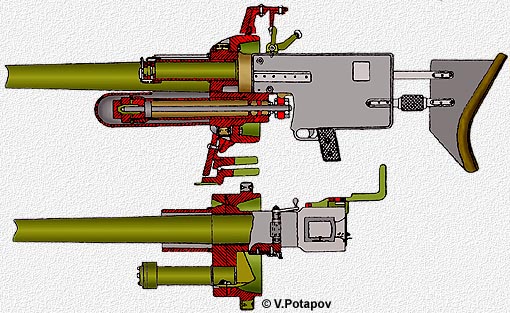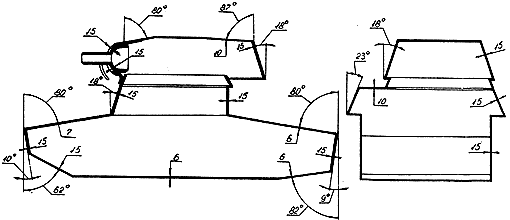| The T-26 Light Tank |
|---|
|
|

The T-26 Light Tank Model 1933.
| The T-26 Light Tank |
|---|
|
|

The first tank of this class was the T-18 (also known as the MS-1) that was developed and produced in 20th. Later, the T-19 and T-20 were intended to replace the T-18, but they were delayed because of trouble with their engines. Thus, those projects were stopped and instead of that, the British light tank "Vickers E" was produced under license (that doesn't mean it was a mass production, rather an attempt to develop a new tank on a "Vickers" base). On 28 May 1929, an agreement with the Vickers corporation was signed and the first party of 15 tanks was delivered to the Soviet Union. Those tanks were named V-26. Their design became a basis for the further Soviet tank modernisation: the TMM-1 and TMM-2. Extensive comparative tests of the B-26, T-19, T-20, TMM-1 and TMM-2 were carried out on the Kubinka proving ground. The T-20 showed the best result, however it was equipped with an experimental engine, that wasn't in a mass production. So, on February 13 of 1931 the RVS signed an order to accept for Red Army service the "Vickers E" light tank under the new designation of T-26 and recommended to start its mass production. The STZ was ordered to start manufacture these tanks (with a 13,800 vehicles of yearly output!). However this industrial plant was still under construction, thus another factory (the "Bolshevik" factory in Leningrad) received the same order. Later, "Bolshevik" was split into two independent factories - "Bolshevik" and #174 "K.E.Voroshilov" which continued to produce the T-26 tanks. Over 10 years this factory produced more than 12,000 tanks of that type. The last tanks were produced at the beginning 1941. The first production T-26 tanks had two turrets and were similar to the original "Vickers." The first party of T-26's served in the Red Army from September 1931 and took part in a military parade on Red Square in November 7. The T-26 became prevalent tank in the Soviet tank forces. Many further projects were based on this tank. However, Soviet tankers strongly disliked this tank. Although it was produced in large numbers, it had still many defects. For example, it had a thin armor and a weak engine. During 1931-1941, 23 modifications were made in attempts to improve its engine. However, engine power was increased from only 90 h.p. to 97 h.p. That was obviously insufficient. |
During the first two years (1931-1932) the only twin-turret model of T-26 was producing. Later, when various modifications appeared, the Red Army designated them as "T-26 model 1931-32", "T-26 model 1933-37" and "T-26 model 1938-39". The T-26A, T-26B, T-26C etc. designations were used by the Germans during the WWII and completely unknown in the USSR (I think we should use the original designations - Valera). Each turret of the twin-turret version was armed with one machine-gun and could rotate on 270°.
The T-26 armament consisted of (depending on version):
- two DT machine-guns;
- the 37 mm gun and the DT TMG;
- the 45 mm gun and the DT TMG.
Tanks armed with a gun were used as commander's tanks; that's why some of them were equipped with radio. The 37 mm gun was originally a Hochkiss gun, modified in the USSR. Later, it was replaced with the Soviet 37 mm PS-2 gun model 1930 (Designer - P.N.Syachentov.) That was a fully redesigned Rheinmetall 37 mm AT-gun Pak 30 with a longer barrel and higher muzzle velocity. Tanks armed with those guns were known as the T-26 Model 1932.

Production of the T-26 with a single turret (the same turret as on BT-5) has started in 1933. That model was equipped with the a 45 mm gun 20K model 1932/38 as well as a DT TMG. That was the most numberous modification of T-26, over 5,000 tanks were built. During the production many changes were made: capacity of the fuel tanks was increased, tank received an antiaircraft machine-gun. After 1937, all tanks started to equip with a 71-TK-3 radio. A powerful searchlight was installed on the gun for a night combat. Different versions of the T-26 carried a various amounts of ammunition.

In 1938, the new T-26 version with the new welded conic turret was developed. The tank was armed with the newest 45 mm gun 20K model 1932/38, advanced gunnery optics and had an increased capacity of the fuel tanks.
The next modification - the T-26 model 1939 - was developed in 1939. That model had a sloped armor and improved engine ventilators that were protected against the "Molotov cocktails" (derived from the combat experience in Spain Civil war). After adding of those modifications, the tank weight increased. Up to end 1939, more than 1,300 tanks were produced.
Even before the World War Two, the T-26 tank took part in many military conflicts. The conflicts in Finland, and Poland are considered part of WWII - at least outside of Russia. In July 1938, the military conflict between Soviet and Japanese forces began at Hasan Lake and again, T-26's were used. From the Soviet side there were: A.P.Panfilov's 2nd Independent Mechanized Brigade (three battalions of T-26, a battalion and a company of "BT" tanks and a company of experimental SU-5 SP guns), which was attached to the 39th Rifle Corps, the 32nd (of major M.V.Alymov) and 40th (commander - 1st lieutenant Sitnikov) Independent Tank Regiments. In total, 351 tanks were used in those battles: 257 T-26's, 81 BT tanks and 13 SU-5's. Soviet losses were: 9 destroyed and 76 damaged T-26's, plus a 8 BT tanks destroyed. 39 tanks were repaired soon, another 40 tanks were sent back to the factories due to their heavy damages. Many tanks were damaged because of technical difficulties: gearbox or friction clutch failures. |
In August 1939, Soviet tank forces had over 8,500 T-26 tanks. At the beginning of the Great Patriotic War, they were the most common tanks in the Red Army. Over 12,000 tanks were produced. It was intended as an "infantry" tank, i.e. for close support during an infantry attack. Each Soviet rifle (infantry) division had one company of those tanks. |
In 1933, a new project of the infantry tank was finished. The tank was based on the T-26 tank and named "P-T-26". However the project was abandoned, but the next project - artillery tank "T-26A" or "T-26-4" - was finished and even produced in limited numbers. It had the same turret as on the BT-7A tank and a 76.2 mm KT-26 gun. Tank was intended for direct artillery support of tank attacks. In 1934-1935, 65 tanks were manufactured and after that, production was canceled.
T-26PT - twin turret command tank, 1931-1933. Was equipped with 71-TK-1 wireless, 96 tanks were produced.
OT-26 (HT-26) - flame-thrower (chemical) tank 1933-1934. Armament: flame-thrower and one machine-gun. A few tanks were produced.
T-26PT - single turret command tank, 1933-1940 equipped with 71-TK-3 wireless. Armament: 45 mm 20K gun model 1932/38, 2 machine-guns. Total 3938 tanks were produced.
T-26A (T-26-4) - artillery tank, 1933. Armament: 76.2 mm KT-28 gun, 2 machine-guns. A few tanks were produced.
ST-26 - a bridgelayer tank, 1933-1935. Armament: one machine-gun. 65 tanks were built.
TT-26 - a radio control (telemechanic in Russian terms) flame-thrower tank, 1935-1936. Armament: flamethrower, one machine-gun. 55 tanks were built. Used together with the TY-26 tank only.
TY-26 - a radio control (telemechanic in Russian terms) command tank, 1935-1936. Armament: 45 mm 20K gun, one machine-gun. 55 tanks were built. Used together with the TT-26 tank only.
OT-130 - a flame-thrower tank, 1938. Armament: flame-thrower, one machine-gun.
OT-131 - a flame-thrower tank, 1938. Armament: flame-thrower, one machine-gun. A few tanks were produced.
OT-132 - a flame-thrower tank, 1938. Armament: flame-thrower, one machine-gun. A few tanks were produced.
OT-133 - a flame-thrower tank 1939. Armament: flame-thrower, 2 machine-guns.
OT-134 - a flame-thrower tank 1940. Armament: 45 mm 20K gun, flame-thrower, 2 machine-guns. 1336 tanks were produced.


| REFERENCES: Blueprints of the T-26: sheet 1 and sheet 2 The profile of the T-26 light tank Specification of Soviet tanks Specifications of Soviet tank guns The Glossary of Soviet Terms and Abbreviations |
Sources:
M.Baryatinsky "Soviet tanks in World War Two" 1995 "Light tanks of the Red Army 1931-1939" 1997 Cover picture - A.Zhirnov |